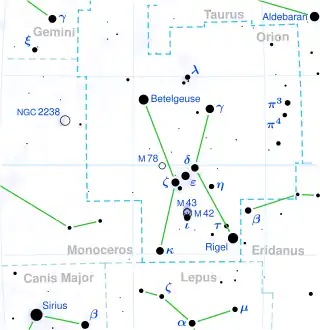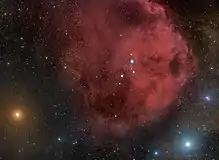 | |
| Observation data Epoch J2000.0 Equinox J2000.0 (ICRS) | |
|---|---|
| Constellation | Orion |
| Right ascension | 05h 36m 54.38819s[1] |
| Declination | +09° 17′ 26.4096″[1] |
| Apparent magnitude (V) | 4.081[2] |
| Characteristics | |
| Spectral type | G8 III-IV[3] |
| U−B color index | +0.618[2] |
| B−V color index | +0.966[2] |
| Astrometry | |
| Radial velocity (Rv) | +98.96±0.09[4] km/s |
| Proper motion (μ) | RA: +97.24[1] mas/yr Dec.: −305.57[1] mas/yr |
| Parallax (π) | 27.76 ± 0.27 mas[1] |
| Distance | 117 ± 1 ly (36.0 ± 0.4 pc) |
| Absolute magnitude (MV) | +1.33±0.07[5] |
| Details[4] | |
| Mass | 1.07±0.04 M☉ |
| Radius | 7.72±0.27 R☉ |
| Luminosity | 31.6 L☉ |
| Surface gravity (log g) | 3.00±0.02 cgs |
| Temperature | 4,856±11 K |
| Metallicity [Fe/H] | −0.56±0.02 dex |
| Rotational velocity (v sin i) | 1.91±0.53 km/s |
| Age | 6.91±1.04 Gyr |
| Other designations | |
| Database references | |
| SIMBAD | data |

Yellow φ2 Orionis with nebulosity east of φ1 Orionis and south-east of λ Orionis
Phi2 Orionis is a star in the constellation Orion, where it forms a small triangle on the celestial sphere with the nearby Meissa and Phi1 Orionis.[7] This star is visible to the naked eye with an apparent visual magnitude of 4.081.[2] Based upon an annual parallax shift of 27.76 mas,[1] it is located around 117 light-years from the Sun.
This is a G-type giant or subgiant star with a stellar classification of G8 III-IV[3] that, at the age of 6.9 billion years, is evolving away from the main sequence. It has 1.07 times the mass of the Sun, but has expanded to 7.72 times the Sun's radius. The star shines with 31.6 times the solar luminosity from its outer atmosphere at an effective temperature of 4,856 K.[4]
References
- 1 2 3 4 5 6 van Leeuwen, F. (2007), "Validation of the new Hipparcos reduction", Astronomy and Astrophysics, 474 (2): 653–664, arXiv:0708.1752, Bibcode:2007A&A...474..653V, doi:10.1051/0004-6361:20078357, S2CID 18759600.
- 1 2 3 4 Cousins, A. W. J. (1984), "Standardization of Broadband Photometry of Equatorial Standards", South African Astronomical Observatory Circulars, 8: 59, Bibcode:1984SAAOC...8...59C.
- 1 2 Frasca, A.; et al. (December 2009), "REM near-IR and optical photometric monitoring of pre-main sequence stars in Orion. Rotation periods and starspot parameters", Astronomy and Astrophysics, 508 (3): 1313–1330, arXiv:0911.0760, Bibcode:2009A&A...508.1313F, doi:10.1051/0004-6361/200913327, S2CID 118361131.
- 1 2 3 Jofré, E.; et al. (2015), "Stellar parameters and chemical abundances of 223 evolved stars with and without planets", Astronomy & Astrophysics, 574: A50, arXiv:1410.6422, Bibcode:2015A&A...574A..50J, doi:10.1051/0004-6361/201424474, S2CID 53666931, A50.
- ↑ Charbonnel, Corinne; et al. (April 1998), "Mixing processes during the evolution of red giants with moderate metal deficiencies: the role of molecular-weight barriers", Astronomy and Astrophysics, 332: 204–214, arXiv:astro-ph/9712207, Bibcode:1998A&A...332..204C.
- ↑ "phi02 Ori". SIMBAD. Centre de données astronomiques de Strasbourg. Retrieved 2016-11-30.
{{cite web}}: CS1 maint: postscript (link) - ↑ Kaler, James B. (February 10, 2012), "Phi-1 Orionis", Stars, University of Illinois, retrieved 2016-11-30.
This article is issued from Wikipedia. The text is licensed under Creative Commons - Attribution - Sharealike. Additional terms may apply for the media files.